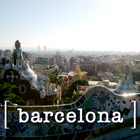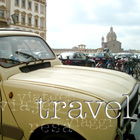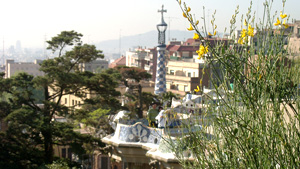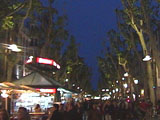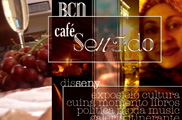
¿BARCELONA ME ENAMORA?
|
Updated 19 December 2005 Blessed with luxuriant geography, Barcelona is situated between two rivers, along the Mediterranean coast, and framed by the Serra de Collserrola massif. The landscape is naturally verdant and lush, and the present day city includes many barrios which used to be farming villages. Visitors can look out over the entire valley from Mount Tibidabo (a reference to the Biblical temptation of Jesus by the Devil, saying "this I give to you").
Barcelona is the capital of autonomous Catalunya, which occupies the northeastern corner of Spain, along the Pyrenees, bordering France. Catalán regional nationalism has a long and storied tradition, rooted in the culture of the Catalán language itself, a romance language independent of Castilian Spanish, whose closest relative is the Langue d'Oc, of southern France, not the Castilian language spoken throughout Spain and Latin America. The sense of a separate and unique cultural ancestry has spawned a tradition of vigorous trade, independent political organization, and democracy, which Cataláns proudly recognize as their natural affinity for egalitarian ideals and an aversion to top-down rule. Primped and polished for the 1992 Olympics, Barcelona has surged in recent years, attracting eager visitors from around the world and establishing itself as one of Europe's key cultural hubs. Politically, Catalunya functions as an independent state within the Spanish nation, and runs its own parliamentary system, has a President, and is given to coalition governments, negotiation and diplomacy.
The city's industrial and political history is pockmarked with sporadic sectarian and class-based violence, but contemporary Barcelona is a safe, sprawling city with an ambiance that welcomes any traveler and invites all to return. Among the great treasures of the city are its architectural landmarks, many modernist mosaic-adorned fantasy, some ancient, and of course the elegant Gothic Quarter. Barcelona's great dream cathedral, El Temple de la Sagrada Famìlia, among the first and most ingenious designs of the visionary modernist, Antoni Gaudí (1852-1926), is still under construction, more than 100 years after building began.
But the heart of Barcelona is where one finds the greatest depth of its history: the Barri Gòtic and the Barri de la Ribera, on the other side of the Via Laietana. In the Old City, you can walk in the footsteps of medieval merchants, kings and adventurers, see the site of Europe's oldest continuously operating stock exchange, and the roots of Catalán democracy, and trace the evolution of the creative genius of painter Pablo Picasso, in a Renaissance villa on the Carrer de Montcada. The city's history extends back beyond ancient times, and some speculate about who the original inhabitants may have been. Traces of an agricultural people, the Laietani, are found in the surrounding region, but there is no clear tie to an urban Barcelona. They are remembered by the Via Laietana, a grand boulevard running from the center of the city down to the port, splitting the Old City. There are more extensive Greek and Roman settlements to the south and north of Barcelona, but the city has its classical history as well, which visitors can tour, beginning at the Museum of the City of Barcelona.
Roman influence over the local Celtic and Iberian languages contributed to the development of the romance languages that came to predominate on the Peninsula. Catalán would later emerge from Latin, but independently of Castilian Spanish. Historians believe this was due to Roman demographics throughout the Peninsula. While officials settled in the rich southern cities, soldiers and those responsible for peninsular trade settled near the Catalán and Valencian ports. In the year 15 BC, Caesar Augustus established a colony on the site of present day Barcelona, but it went on essentially serving as an encampment, while the center of coastal Roman Catalunya was Tarraco (modern Tarragona) to the South. Called Barcino, the town was fortified by Roman walls. A temple was built to honor Augustus, and a Roman forum was established. The walls are still visible at street level, and traces of Roman constructions have been found beneath some of the older official buildings of the Barri Gòtic.
In Medieval times, Barcelona was chartered under a document known as the Usatges, a collection of laws and resolutions set forth to ensure elective government and peaceful succession, as well as a distribution of power and wealth. The Usatges were rooted in tenets which preceded the Magna Carta. The government of the city was known as the Consell de Cent (the Council of 100), to which delegates were elected by various industries and guilds. The votes of laborers were given equal weight to those of the wealthy and landed. It is from this tradition that Barcelona's emblematic trade unions would eventually emerge. Catalán regionalism has been stoked over the centuries by attempts to suppress or eliminate the language itself. In 1714, when Catalunya found itself on the losing side of the War of Spanish Succession, Felipe V banned the public use of Catalán. He had hoped to eliminate resistance from Catalunya by extinguishing its cultural identity, but the Cataláns kept speaking their native tongue, and would thrive again.
The Eixample, or expansion, is Barcelona's famed grid of blocks running from the borders of the Old City uptown (up the sloping city toward the hills, toward Gracia. It was built in the 19th Century, when the city's population was literally overflowing the limits of the constructed urban quarters of the time. The plan for expansion was developed by Ildefons Cerdà i Sunyer, who wanted to implement social policies while expanding the burgeoning metropolis in a practical and elegant way. He designed a strict grid, disrupted only by necessary avenues, and in which the buildings themselves would cooperate with the residents to engender Cerdà's vision of a harmonious community. The new structures would house not only people of all classes, but also all of the necessary services to form a community, within a few blocks. Each block would have at its center an open-air park or courtyard, for public gatherings and social interaction, and the different floors would be divided by material worth, so that workers stayed in the same buildings as their employers, industrial directors and political leaders. Cerdà believed that industrialization was immiserating the average human being, and that this would have disastrous effects for civilization itself, let alone for the progress toward a liberal system of political organization.
Cerdà's structural framework was embraced, but his social policy was brushed aside, either by inertia or by the spirit of the times. Either way, city officials failed to see the merit of his vision for community building and set about implementing the expansion according to their own convenience. They added or removed key design elements in such a way that they would diminish the social benefits and quality of life improvements. Less trees were planted than was planned. Interior courtyard gardens were reduced or covered over completely to make room for storage and commercial space. The buildings became taller and continued to encroach on the interior of their respective blocks. Fewer parks were built, and the effect was more detached than what Cerdà had wanted. During the late 19th Century, Barcelona consolidated its industrial strength and played host to a universal exposition. The times were turbulent, as clashes between labor unions and industrialists were magnified by underworld corruption and violence. The city passed through a time of crisis, but emerged into the 20th Century rich in cultural, material and political improvements, preparing itself for the coming of a second Spanish Republic.
The modernists reshaped the city's image with their ornate and sumptuous architectural visions. Antoni Gaudí, under the patronage of Count Eusebi Güell, became the emblematic visionary of the beautiful bustle of his city. His colorful flights of fancy obeyed laws of engineering that no one else could see clearly, let alone conceive, rooted in the structures of natural landscapes and organisms. Even today, as construction continues on his lyrical Temple de la Sagrada Famìlia, architects are blazing new trails in structural engineering in order to realize his original designs. Gaudí's stunning Parc Güell was intended to be part of a new suburban expansion of Barcelona, designed to attract new money from the merchant class and the political and social elite, but (according to legend) the socialites in the target market couldn't bear the idea of commuting, and chose to stay in the fashionable Eixample, where they could keep up with goings on. So the park stands alone, an oasis that hints at a fantasyland urb that resides somewhere beneath Barcelona's actual surface, in the artistic and civic spirit of its inhabitants. His trencadis trim of broken tile and glass fragments became a favorite feature of modernist ornamentation, and is now a staple in the imaginations of most visitors to Barcelona. But the modernist architects formed only one component of the cultural explosion of turn of the century Barcelona. Painters like Pablo Picasso and Santiago Rusinyol stalked the Old City, held tertulias and mingled with writers, political thinkers and bohemians.
The Barri Gòtic still has a bohemian charm. It's ancient streets are lined with art galleries and shops, but also with cafés, bars and night clubs. At night, by way of Las Ramblas, Barceloneses and foreign tourists mingle with the young night club crowd, strolling from the Plaça Catalunya to the port, and wandering into the winding streets of the Old City. Restaurants, shows, cafés and the revered Barcelona Opera offer a wealth of options for spending the wee hours, and enjoying the contemporary Spanish custom of a sleepless night on the town. [s]
For more travel listings, original narratives and destinations, consult SentidoNews' sister site for travel, CavaTravel.com... |
|||||||||||||||||||||||||||||||||||||||||||||||||||||||||||||||||||||||
|
||||||||||||||||||||||||||||||||||||||||||||||||||||||||||||||||||||||||
